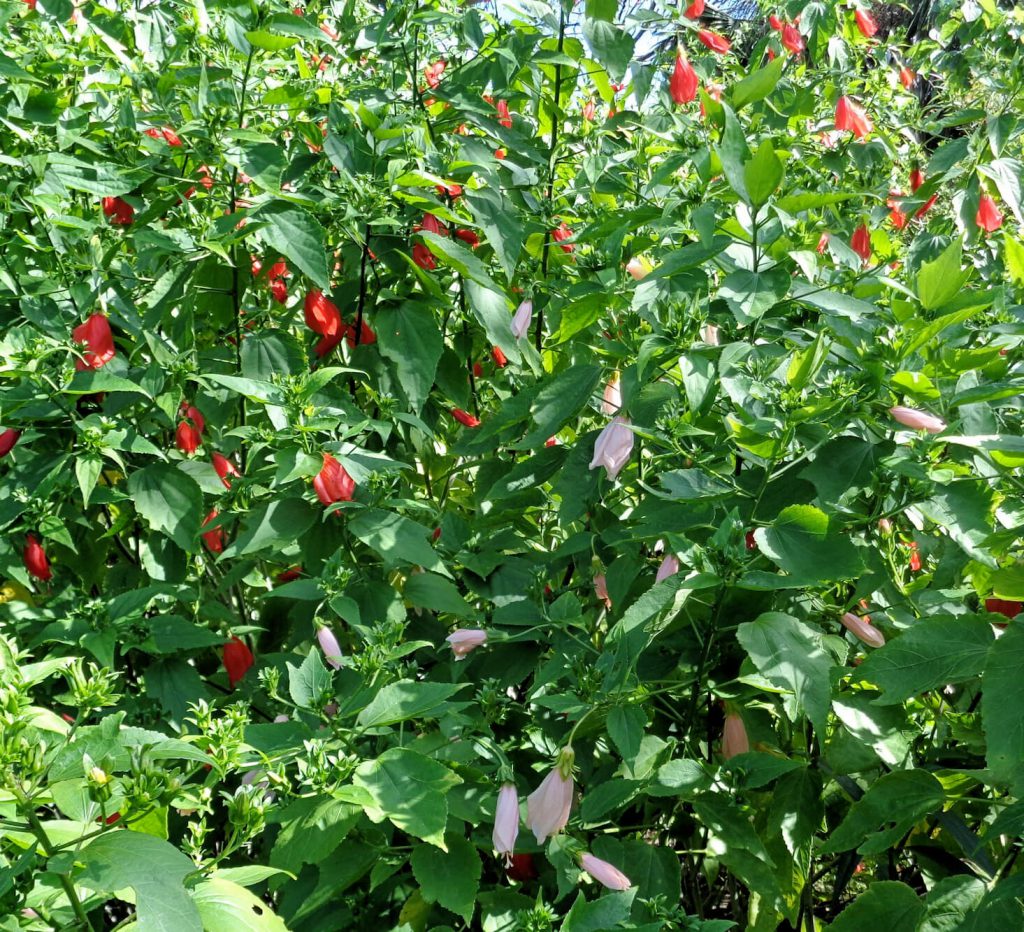By Ralph E. Mitchell

While some can struggle with growing hibiscus due to nematodes, bud midges and nutrient deficiencies, an easy-to-grow relative, the sleeping hibiscus, is a charming shrub in full bloom right now. Don’t let the name “sleeping” cause you any concern, this flowering shrub provides an awakening to the possibilities of color and variety in the landscape.
The sleeping hibiscus or Turk’s cap is widely naturalized throughout Florida, but probably had its origins in Mexico. There are several species, but the most popular seems to be Malvaviscus penduliflorus which sports unopened, dangling flowers in red, white or pink. A very vigorous shrub, the sleeping hibiscus will grow at least six-foot tall without pruning. I prune mine in the spring to keep them in-bounds and to neaten up the bushy mass of growth. Give it room to grow as a mass planting, or plant as a single, groomed specimen. The dependable late summer/fall bloomer has two and one-half inch long blooms that look like they are about to open. They never do fully open, but hang downward in an ornamental fashion favored by hummingbirds. I have also seen bees pry their way in and enjoy the flowers as well.
Sleeping hibiscus enjoy some light shade, but not so much as they become leggy. They are moderate in drought tolerance once established, but not very salt tolerant. Sleeping hibiscus fill a spot during the year when other plants are not blooming. I originally had just red, but found a single pink specimen at a garden center to contrast the colors. I am also on the hunt for a white cultivar which is often available on-line at mail order plant sites.
The sleeping hibiscus is a Florida-Friendly Landscaping™ approved plant. I purchased my original two plants at a local plant sale years ago. This is a common pass-along plant shared by friends and neighbors, but are often spotted at community plant sales. They are also occasionally seen at local garden centers or specialty family-run nurseries, and on-line.
Sleeping hibiscus are perhaps the most user-friendly flowering shrub I cultivate. While they have few if any flowers during the summer, you will be rewarded with flower dividends now through early winter. Plant some of these Florida-Friendly Landscaping plants and you will want more! For more information on ornamental flowering shrubs suitable for area, or to ask a question, please visit https://www.facebook.com/CharlotteMGLifeline/. Ralph E. Mitchell is the Director/Horticulture Agent for the UF/IFAS Charlotte County Extension Service. He can be reached at 941-764-4344 or ralph.mitchell@charlottecountyfl.gov.
Don’t forget that Florida-Friendly Landscaping™ is a program that our office encourages as it promotes planting the “right plant in the right place”, water conservation, common sense pest management, sensible use of fertilizers, composting, etc. that help develop a sustainable landscape. For more information on this important, over-arching program, please contact Sara Weber, FFL Education-Training Specialist, at Sara.Weber@charlottecountyfl.gov .
Resources:
UF/IFAS Gardening Solutions – Turk’s Cap Mallow. The University of Florida Extension Service, IFAS
The Florida-Friendly Landscaping™ Guide to Plant Selection & Landscape Design (2010) The University of Florida Extension Services, IFAS.
Klingaman, G. (2013) Plant of the Week: Mallow, Turk’s Cap University of Arkansas
Dave’s Garden (2020) Malvaviscus Species. https://davesgarden.com/guides/pf/go/170054/
 2
2
